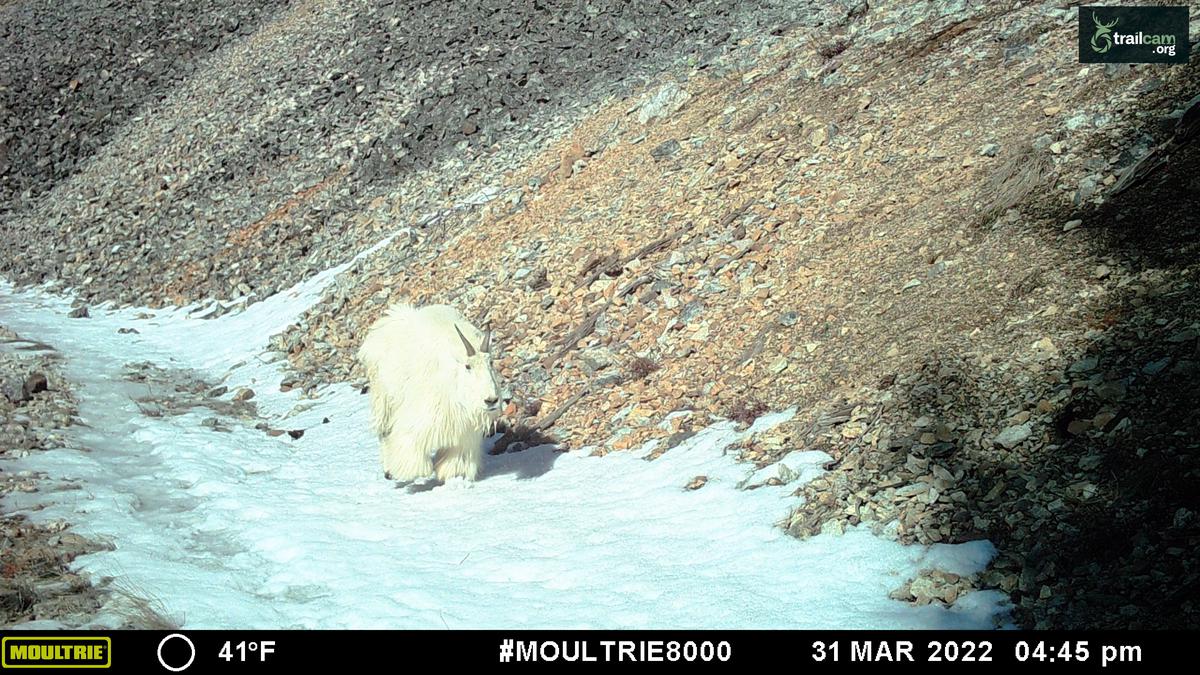Mountain Goat vs. Bighorn Sheep

Billy the Mountain Goat
Captured: March 31, 2022Mountain Goat picture taken by Moultrie M-8000
Camera Model: Moultrie M-8000
Manufacturer: Moultrie
Animal: Mountain Goat Family: Bovids (Bovidae)
Article Summary - TLDR
This article explores the similarities and differences between mountain goats and bighorn sheep, two iconic animals in North America. They differ in their appearance, habitat, diet, and behavior. Mountain goats prefer high elevations and mainly eat alpine vegetation, while bighorn sheep can be found in various habitats and have a more varied diet. Both are social animals, but their behavior is different during the breeding season. Conservation efforts have helped to stabilize their populations, and they are considered of "least concern" by the IUCN, except for bighorn sheep in Mexico, which are endangered.
Mountain Goat vs. Bighorn Sheep
Author: trailcam
Published: March 14, 2023, 7:56 p.m.
Mountain goats and bighorn sheep are two of the most iconic and impressive animals found in the North American wilderness. These two animals are often compared and confused with each other, but they have many differences that set them apart. In this article, we will explore the similarities and differences between mountain goats and bighorn sheep.
| Mountain Goats | Bighorn Sheep | |
|---|---|---|
| Horn Length | 9-12 inches | 30-40 inches |
| Horn Weight | 5-6 lbs | 30-40 lbs |
| Horn Shape | Short, black and straight | Long, curved and yellowish-brown |
| Body Weight | 125-180 lbs | 100-300 lbs |
| Body Length | 4-5 ft | 5-6 ft |
| Shoulder Height | 2.5-3.5 ft | 3-3.5 ft |
| Coat Color | White, shaggy with black horns | Brown, shaggy with white belly |
| Life Span | 9-12 years | 10-14 years |
| Habitat | Steep mountainous terrain | Mountainous and rocky terrain |
Note: The above measurements and statistics are approximate and may vary based on different factors such as location, age, gender, and diet.
Appearance:
One of the most striking differences between mountain goats and bighorn sheep is their physical appearance. Mountain goats are known for their thick, shaggy, white coats and black horns. Bighorn sheep, on the other hand, have short, fine hair that ranges from light brown to dark gray or black, and their curved horns are a distinctive feature. The horns of the male bighorn sheep can weigh up to 30 pounds, while the horns of the female are much smaller and less curved.
Habitat:
Mountain goats and bighorn sheep both live in mountainous regions but have different habitat preferences. Mountain goats prefer the highest elevations of rocky mountain ranges, while bighorn sheep can be found in a variety of habitats, including alpine meadows, low-elevation deserts, and rocky canyons. Both animals are adapted to living in steep, rocky terrain and are excellent climbers, but mountain goats are better adapted to life in higher elevations, where oxygen levels are lower.
Diet:
Mountain goats and bighorn sheep have different dietary preferences. Mountain goats are true herbivores, eating mainly grasses, sedges, and other alpine vegetation. Bighorn sheep are also herbivores but have a more varied diet that includes shrubs and other woody plants. Both animals are able to survive in their respective habitats with a diet that is suited to the local plant life.
Behavior:
Mountain goats and bighorn sheep are both social animals, but their behavior is different. Mountain goats are often found in groups, known as bands, consisting of females and young, led by a dominant male. Male mountain goats are territorial and will fight for breeding rights with females. Bighorn sheep are also social but form larger herds consisting of both males and females. During the breeding season, males engage in head-butting battles for dominance, with the winner earning the right to mate with the females.
Conservation Status:
Both mountain goats and bighorn sheep have experienced population declines in the past due to overhunting and habitat loss. However, conservation efforts have helped to stabilize their populations. Currently, mountain goats are considered a species of "least concern" by the IUCN, while bighorn sheep are considered a species of "least concern" in North America but are considered endangered in Mexico. In conclusion, mountain goats and bighorn sheep are both impressive animals with many unique and interesting characteristics. Although they may look similar at first glance, they have different physical features, habitat preferences, dietary needs, and behavior patterns. Learning more about these animals can help us to appreciate the diversity of life in our world and understand the importance of conservation efforts to protect these iconic species for future generations.




